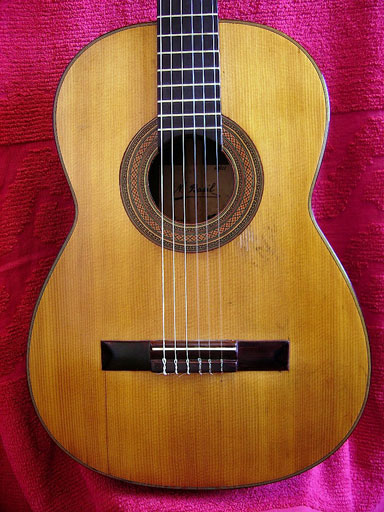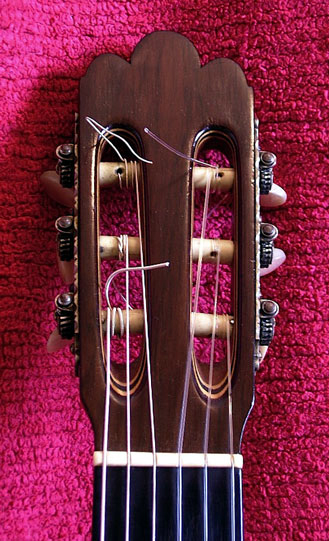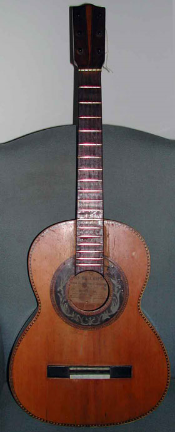

Bautista Alcañiz (Barcelona, active c. 1890–1930)
Bautista Alcañiz, born in Valencia, was part of the firm Ribot and Alcañiz, based in Barcelona. The firm operated from the late 19th century to the early 20th century, producing high-quality instruments.
Nicolás Basil (Barcelona, active c. 1926–1930s)
Nicolás Basil established his workshop at Calle del Arch Nou de San Ramón del Call, 11, in 1926. Like Enrique Sanfeliú, he was influenced by Enrique Garcia. A 1933 guitar by Basil features a headstock design that pays homage to Garcia and is noted by its owner for its "campanitas" (little bells) sound. The rosette design also resembles those used by Sanfeliú.
Cassas (Barcelona, active early 19th century)
Cassas was a luthier active in Barcelona during the first half of the 19th century. Although his first name is unknown, one of his instruments is part of the collection at the Royal Conservatory of Brussels.
Agustín Altimira-Codina (Barcelona, b. 1805, active c. 1837–1880, d. 1884)
Agustín Altimira-Codina, born in Barcelona in 1805, crafted violins and guitars from 1837 to 1880. He studied violin making under the French luthier Étienne Marie Breton, who moved to Spain in 1850 to oversee Altimira's workshop until 1874. Altimira initially worked on Calle de Escudiller, where Fernando Sor lived as a child, later relocating to La Plazuela de San Francisco in 1860. His early guitars reflected the French Mirecourt school, lacking fan bracing, but his later works adopted fan bracing, influenced by Torres and Arias. In 1878, he won a silver medal at the Paris Exposition for a highly decorated guitar. He passed away in 1884.
Enrique Coll (Barcelona, active c. 1940s)
Enrique Coll, a Barcelona-based maker of classical and flamenco guitars during the 1940s, was trained by Francisco Simplicio. He operated his workshop at Calle Caspe, No. 35.
Nicolas Duclos (Barcelona, active 1744–1781)
Nicolas Duclos was a French luthier who relocated to Spain, working in Madrid and Barcelona from 1766 to 1781. In addition to violins, he crafted mandolins and guitars.
Francisco Pedro España (Barcelona, b. 1793, active 1820–1877, d. 1877)
Francisco Pedro España, born in 1793 in Sant Joan les Fonts, Gerona, studied under Thérèse, a luthier from Mirecourt, France, starting around 1820. He worked with Thérèse until 1835. España was a highly successful luthier who managed a workshop employing several craftsmen. Alongside violins, violas, cellos, double basses, and pianos, he produced exquisitely decorated guitars using exotic woods.
Juan Estruch Pipó (Barcelona, active 20th century)
Juan Estruch Pipó, a Barcelona luthier, was the grandson and successor of Juan Estruch Sasate, continuing the family’s long tradition of guitar making.
Juan Estruch Rosell (Barcelona, active late 19th century)
Juan Estruch Rosell was the founder of the Estruch dynasty of guitar builders. He opened his shop in Barcelona in 1880 and was the father of Juan Estruch Sasate and grandfather of Juan Estruch Pipó. From 1898 to 1922, the family built guitars under the name Hermanos Estruch, operating a series of workshops. From 1898 to 1901, they were located at Calle Ancha 50, and in 1902, they moved to Calle Ancha 30.
Juan Estruch Sasate (Barcelona, b. 1895 – d. 1970)
Juan Estruch Sasate, a Barcelona luthier, was the son and successor of Juan Estruch Rosell.
Juan Fenoy (Barcelona, active 1930s)
Juan Fenoy was trained by Miguel Simplicio. He produced Torres copies, not with the intent to deceive, but to demonstrate that he was as skilled a luthier as Antonio de Torres.
Bienvenido Fleta (Barcelona, b. 1882 – d. 1971)
Bienvenido Fleta, the eldest of the three Fleta brothers, was born in Huesca. Influenced by his brothers Francisco Manuel (1890–1981) and Ignacio (1897–1977), he became a luthier and joined them in Barcelona after they opened a workshop in 1915. He was trained by Francisco Manuel.
Ignacio Fleta (Barcelona, b. 1897 – d. 1977)
Ignacio Fleta, the youngest son of a cabinet maker, had two brothers who also became luthiers: Bienvenido (1882–1971) and Francisco Manuel (1890–1981). The family hailed from Huesca in the province of Teruel. Ignacio inherited his love of woodworking from his father but was deeply drawn to music, starting guitar lessons at the age of eight.
It was Francisco Manuel who first pursued lutherie, apprenticing with violin maker Benito Jaume (1860–1934) in Barcelona in 1907. After three years, Francisco continued his training under Etienne Marie (1867–1935), a Spanish-born member of the renowned French Mirecourt luthier family. From Francisco Manuel, Ignacio learned the fundamentals of stringed instrument construction.
At 13, Ignacio joined his brother in Barcelona to apprentice at Francisco’s workshop. In 1915, Ignacio and Francisco opened a workshop on Calle Valldoncella, later joined by their brother Bienvenido, who also trained under Francisco. Ignacio not only mastered guitar construction but also developed skill in crafting other stringed instruments, including cellos, which he studied intensively. His passion for the cello led him to train in France with Philippe Le Duc.
In 1927, Ignacio returned to Barcelona and opened his own workshop on Calle de los Ángeles. Known for crafting cellos, bass-viols, and guitars, he gained recognition working for Pablo Casals. Between 1939 and 1945, Ignacio reproduced historical instruments—violins, Gothic harps, vihuelas, lutes, and modern guitars—on commission from the musical society "Ars Musica." This project cemented his reputation as a master luthier.
In 1955, inspired by hearing Andrés Segovia, Ignacio decided to focus exclusively on guitar making. In 1957, he crafted the first of three guitars for Segovia, which propelled him to international fame. Producing only 16 guitars per year, his waiting list grew to legendary lengths. Renowned guitarists such as Alexandre Lagoya, Eduardo Falú, Alberto Ponce, and John Williams owned Fleta guitars.
Ignacio passed away in 1977, leaving his legacy in the capable hands of his sons Francisco (b. 1925) and Gabriel (b. 1929). The Fleta brothers took over the workshop and continued producing high-quality instruments. Now in their seventies, they have stopped accepting new orders.
Francisco Manuel Fleta (Barcelona, b. 1890 – d. 1981)
Francisco Manuel Fleta, born in Huesca in 1890, crafted his first violin at age 15. Recognizing his talent, his father arranged for him to apprentice with violin maker Benito Jaume in Barcelona. After three years with Jaume, Francisco furthered his training under Etienne Marie.
In 1915, Francisco opened his own workshop in Barcelona, where he trained his brothers Ignacio and Bienvenido. Like Ignacio, Francisco traveled to France in the mid-1920s to study with Philippe Le Duc. His violins and cellos were modeled after those of Stradivarius, but he also built guitars and contrabasses, showcasing his versatility as a luthier.
José Massí Forner (Barcelona, d. 1991)
José Massí Forner was a Barcelona-based guitar maker who passed away in 1991.
Juan Maria Garcia (Barcelona, active c. 1900)
Juan Maria Garcia appears to have been active in Barcelona during the late 19th and early 20th centuries, based on the style of his guitar. His label reads:
JUAN MARIA GARCIA / Fabrica de Guitarras y Bandurrias / BARCELONA / Plaza de San Pedro No 403.
Francisco Istrell (Barcelona, active c. 1685)
Francisco Istrell was a luthier making guitars in Barcelona around 1685.
José Massague (Barcelona, b. 1690 – d. 1764)
José Massague, born in Barcelona in 1690, belonged to a carpenter's guild but also crafted guitars and violins. His workshop was located on Calle de Escudillers. He worked as an independent maker from 1725 until his death in 1764.
Francisco Matabosch (Barcelona, active c. 1750–1800)
Francisco Matabosch was a luthier active in Barcelona during the second half of the 18th century.
Joan Matabosch (Barcelona, active c. 1790s–1820s)
Joan Matabosch, likely the son of Francisco Matabosch, was a guitar maker active in Barcelona during the early 19th century. His only known surviving guitar, dated 1815, is housed in the Museu de la Música in Barcelona. Matabosch was a significant figure in late 18th-century Spanish guitar making. Fernando Sor’s first guitar was built by Matabosch, and Dionisio Aguado mentioned owning a finely crafted guitar by him in his memoirs.
Salvio Morbey (Barcelona, active c. 1880)
Salvio Morbey was a luthier in late 19th-century Barcelona, known for creating highly ornate guitars typical of the period.
Ramón Parramón Castany (Barcelona, b. 1880 – d. 1956) and Jacinto Pinto (d. 1956)
Ramón Parramón Castany was born in Montesquiu, Barcelona, in 1880. He established a workshop in Barcelona in 1908, specializing in violins and other stringed instruments. In 1920, Jacinto Pinto joined the workshop. Pinto, a skilled luthier, had trained with Laberte and Magnié in Mirecourt, France, and worked for several years with Etablissements Couesnon in Paris.
After 1921, all the instruments produced by the firm—despite continuing to bear the R. Parramón label—were crafted by Pinto. Their work included violins, other bowed instruments, guitars, and reproductions of early stringed instruments. Parramón passed away in 1955, and Pinto died in 1956, bringing their distinguished collaboration to an end.
Pedro Pérez (Barcelona, active c. 1900s)
Pedro Pérez was a luthier active in early 20th-century Barcelona. He operated a workshop at Calle Gobernador No. 3, Piso 4, producing finely crafted stringed instruments.
Juan Maria Garcia (Barcelona c. 1900)
Jaime Ribot (Barcelona, active c. 1900–1920)
Jaime Ribot was a luthier active in Barcelona during the early 20th century. While specific details about his work are limited, he played a role in the city’s rich tradition of instrument making during this period.
Juan Ribot (Barcelona, b. 1882 – d. 1918)
Juan Ribot, the son of Jaime Ribot, was trained by his father and became an exceptional luthier. Tragically, his promising career was cut short when he passed away at a young age in 1918.
Enrique Sanfeliú Leonor (Barcelona, active 1930s)
Enrique Sanfeliú Leonor (Barcelona, active 1930s)
Enrique Sanfeliú Leonor (Barcelona, b. 1882 – active 1930s)
Enrique Sanfeliú was born in Valencia in 1882. As a child, he displayed a natural talent for woodworking, crafting small guitars that he gifted to other children. His deep connection to the guitar, both as an instrument and an art form, inspired him to study under Manuel Loscos, a disciple of the legendary guitarist Francisco Tárrega. These studies rekindled his passion for guitar making and led him to move to Barcelona to pursue his dream.
In Barcelona, Sanfeliú apprenticed at Casa Estruch, one of the city’s leading guitar-making workshops. He also began frequenting the workshop of renowned luthier Enrique García, observing him at work. Despite the potential for rivalry, García, with the generosity of a master craftsman, openly shared his knowledge and offered guidance to the eager young Sanfeliú.
Sanfeliú remained deeply grateful for García’s mentorship and often expressed pride in having received such invaluable advice. This apprenticeship left a lasting impact on Sanfeliú’s craftsmanship, and his guitars reflect both his individual artistry and the influence of his esteemed mentor.
José Serratosa Blanch (Barcelona, active 1880s–1930s)
José Serratosa Blanch was born in Terrassa, Catalonia, in 1855. As a young man, he apprenticed as a carpenter, but his curiosity and dedication led him to master the intricate art of crafting flamenco and classical guitars.
In 1890, Serratosa moved to Barcelona and established his own workshop, where he worked for the next four decades. Known for his innovative spirit, he introduced several creative designs, including a guitar with a detachable neck, showcasing his ingenuity and practical approach to luthiery. Serratosa’s contributions elevated Barcelona’s reputation as a hub for high-quality guitar making during his era.
Francisco Simplicio Hernandis (Barcelona, 1874-1932)
Here’s the refined version in US English:
Francisco Simplicio (Barcelona, b. 1874 – d. 1932)
Francisco Simplicio was born in Barcelona in 1874. As a young man, he apprenticed as a cabinetmaker at Casa Masriera y Vidal and later worked with Francisco Vidal, a prestigious workshop specializing in fine furniture. His exceptional skill and dedication quickly earned him the title of master craftsman, and he worked as a cabinetmaker for approximately 18 years.
Around 1919, labor disputes and a lockout compelled Simplicio to seek alternative employment. His longstanding friendship with Enrique García, one of the distinguished luthiers who emerged from Manuel Ramírez’s shop, provided him an opportunity to work in García’s workshop. Under García’s mentorship, Simplicio refined his skills and became a master luthier. When Enrique García passed away in 1923, he entrusted his workshop at Paseo San Juan 110 to Simplicio.
In 1929, Simplicio showcased his guitars at the International Exhibition in Barcelona, earning a gold medal for his craftsmanship. Over the course of his career, he built approximately 340 instruments, gaining widespread acclaim for his artistry and innovation. While he took great pride in being a disciple of Enrique García, Simplicio also made significant contributions to the art of guitar making.
One of Simplicio’s most notable innovations was a guitar with double sound holes positioned on either side of the fingerboard. By relocating the traditional central sound hole, Simplicio aimed to expand the vibrating surface of the soundboard, enhancing both the instrument’s volume and tonal richness.
Francisco Simplicio passed away in Barcelona in 1932. His legacy endures through the training he provided to Enrique Coll and his son, Miguel Simplicio, who took over the workshop after his father’s death. Simplicio’s guitars remain highly prized for their exceptional craftsmanship, tonal quality, and forward-thinking designs.
Photo courtesy of: " Il Fronimo",
Photo courtesy of: " Il Fronimo", nr. 113 - Genuary 2001, "Francisco e Miguel Simplicio, in arte liutai" by D. Milanese and U. Piazza. This extensive article may be ordered at: http://www.fronimo.it/
Miguel Simplicio (Barcelona, b. 1899d. 1939)
Photo courtesy of: " Il Fronimo", nr. 113 - Genuary 2001, "Francisco e Miguel Simplicio, in arte liutai" by D. Milanese and U. Piazza.
Miguel Simplicio (Barcelona, b. 1899 – d. 1938)
Miguel Simplicio, the son of Francisco Simplicio, was born in 1899 and trained by both his father and Enrique García. During his father’s lifetime, they worked closely together, with Miguel playing a significant role in the workshop. After his father’s death in 1932, Miguel took over the workshop and quickly gained an international reputation, particularly in Latin America.
Miguel’s guitars commanded extraordinary prices in Argentina during his lifetime, reflecting his growing prestige. Although he is credited with producing approximately 150 guitars under his own label, it is believed that he contributed significantly to many of his father’s instruments as well. Miguel Simplicio passed away from stomach cancer in 1938 at the young age of 39. He left a lasting legacy, including training the luthier Juan Fenoy.









